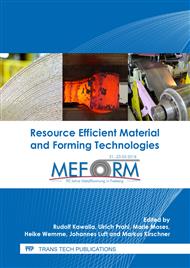p.40
p.48
p.54
p.65
p.71
p.77
p.85
p.95
p.103
Manufacturing of Long-Length Rods of Ultrafine-Grained Ti-Ni Shape Memory Alloys
Abstract:
Ti-Ni shape memory alloys were subjected to a rotary forging (RF) from the diameter of 20 or 12 mm to 5 mm at relatively low temperatures of 450 and 350 °C. The structure was studied using X-ray diffraction analysis and transmission electron microscopy. Mechanical properties were determined by uniaxial tensile and Vickers hardness tests, and the maximum completely recoverable strain by a thermomechanical method. The obtained results showed that RF at low temperatures allows manufacturing 3 m-long Ti-Ni rods. A mixed submicrocrystalline and nanosubgrained structure with an average size of structural elements of 118 ± 7 nm after forging from 20 mm, and 126 ± 7 nm after forging from 12 mm at 350 °С provides the highest mechanical (σв = 1113 MPa after forging from 20 mm, and 1065 MPa after forging from 12 mm) and functional (maximum completely recoverable strain of 8.0 %, after post-deformation annealing at 400 °С, 1 h) properties as compared to the initial state before RF (700 MPa, and 4.4 %, respectively).
Info:
Periodical:
Pages:
71-76
Citation:
Online since:
March 2018
Permissions:
Share:
Citation:


